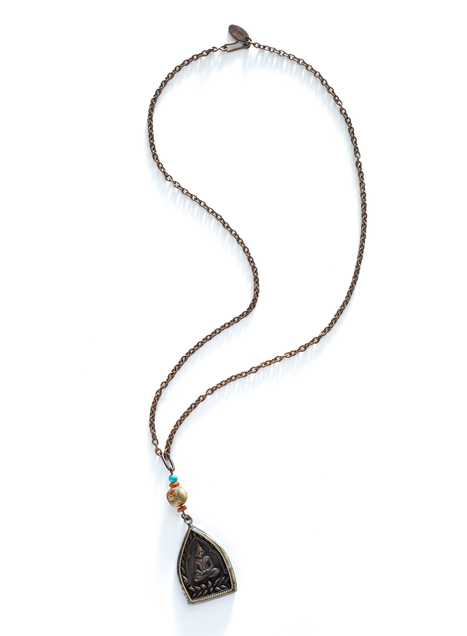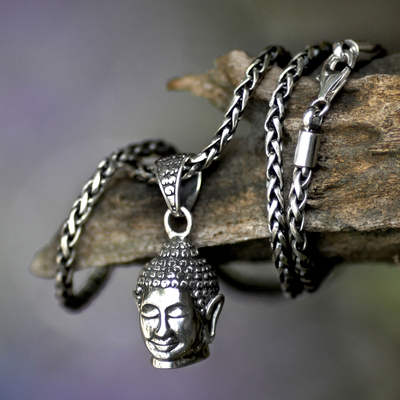It's not unusual for people to become more interested in Buddhist practices as they get older. This may include wearing jewelry. For both men and women pendant necklaces featuring Buddha as well as other auspicious Buddhist images are the most common form of Buddhist jewelry. Buddhism affirms that our happiness is not dependent on the material things we own. If we purchase Dharma items with the intention to improve our practice, this kind of materialism could be thought of as a form of skilled means. It can encourage us to cultivate more spiritual qualities such as empathy and tolerance throughout our daily life. As time passes, our practice can be a source of awakening and eternal happiness. While it isn't something we associate as spirituality However, certain Buddhist teachers have warned their students about the dangers of it in the practice of one's own. Chogyam Trungpa (a Tibetan Buddhist master) popularized the concept of "spiritual materialism" in his book, cutting Through Spiritual Materialism. He explained the ways that people utilize religion to enhance their individuality and ego-grasping. Our spiritual practice that is meant to reduce our egocentricity seems to only increase it. Since the ego is able to manipulate everything for its benefit and even the things we are supposed to make us feel less egocentric, we often find ourselves in a situation in which our spiritual practices actually serve to fuel our self-centeredness. This is more frequent than we realize. It can be manifested as feeling satisfied with our spiritual experience and attending high-ranking instructors in order to prove it they are spiritual just because we're spiritual.
When we purchase Dharma items, there is an actual risk that we might use such items to further fortify our status as an Buddhist and put too much emphasis on the label of being a Buddhist instead of what it really means to be Buddhist. The spiritual teachings of our teachers, and practices (as with practice items or clothing), shouldn't be taken as a means to increase our self-esteem or push us closer to an obsession with self-gratification and ego. Everything on the Buddhist path is designed to soften our hearts and minds, reduce selfish grasping, and help us become more compassionate, kind and conscious of the fundamental Buddhist principles that guide our daily lives (such as the Four Noble Truths). Have a look a the recommended Buddha Necklaces for information.

To be a Buddhist practitioner is to look at ways of meditating and developing our spirituality in every situation that we find ourselves in throughout the day. It is not enough to understand the fundamentals of the Buddhist teachings. The teachings must have the same effect as sweet milk being put into water. They must be mingled entirely with our minds, so there is no separation between the Buddhist principles of our lives and the principles of the Buddhist teachings. If the Buddhist teachings and practices don't help us to be more aware of the world around us, gentle, compassionate and loving then it's time to consider how we incorporate the Buddhist practices in our daily lives. The most important reason to purchase Buddhist items is to remind ourselves to do more. Buddhist teachers frequently give pendants to their students (like the ones below) for this exact reason. If we buy such items to gift others, the image will make them an important and auspicious gift. Here is a brief description about some Buddhist imagery found on Buddhist pendants, rings or even earrings. It also includes some Amazon listings.
Buddha - Wearing images or other symbols of the Buddha can help us be more Buddhist throughout the day. It may help us be more patient, kind in our speech and mindful of cultivating peace and non-violence. Due to the significance of the symbol, you can get pendants that only show the hands and head of the Buddha. I suggest you purchase ones that depict the entire body of the Buddha. Most cases show the Buddha in meditation posture or a earth-touching pose. This indicates that the Buddha summoned the Earth to witness his Enlightenment. See the leading Om Mani Padme Hum Bracelets for tips.

Lotus - The lotus symbolizes that every day brings out our spiritual qualities of compassion, wisdom, contentment, love, and wisdom. Just as a lotus grows out of a muddy pond the lotus signifies that our spiritual qualities can bloom even in the chaos of suffering and Samsara. It is always our choice to cultivate positive, healthy mental states like tolerance and compassion, regardless of what life can throw at us. And just as it takes time and effort for that lotus to grow out of the darkness and mud and mud, with a little determination and joyful effort, our mind will blossom into something wonderful and radiant and become a source of our awakening. In Buddhist imagery, Buddhas and bodhisattvas are usually sitting or standing on lotuses. This symbolizes that like the murky water isn't able to stick to the lotus' petals but is easily able to flow away, Buddhas and bodhisattvas can remain in Samsara to serve living beings, without being touched or polluted due to its flaws (due to their clean mind and attainments).
Wheel of Dharma – Wearing the Wheel of Dharma will help you recall all of the Buddha’s instructions. The Wheel of Dharma is also identified by the Dharmachakra and symbolizes the Buddha’s teachings. The most popular wheel is the one with eight spokes. It represents the Noble Eightfold Path, or Right View, Right Action and Right Mindfulness. Sometimes, the center of the wheel can be split into three pieces; these are often known as the Three Jewels (the Buddha Dharma Sangha), The circular shape could be symbolic of the concept of rebirth that continues until awakening. The belief was that the Buddha was a person with an impression of an eloquent thousand-spokewheel on each his soles. The Wheel of Dharma refers to one of eight auspicious symbols that is connected to Buddha. Have a look a the leading Buddha Pendants for info.

